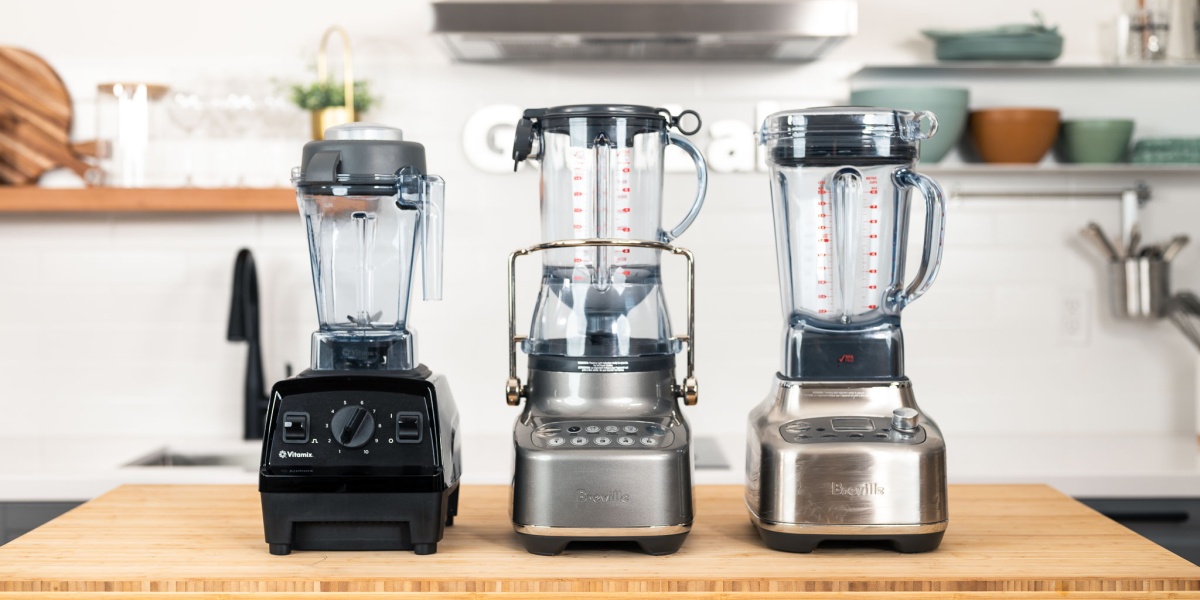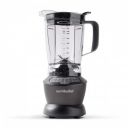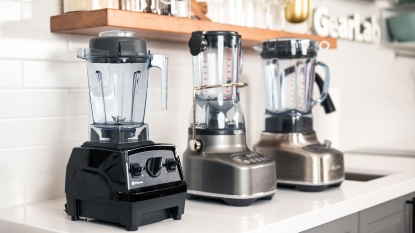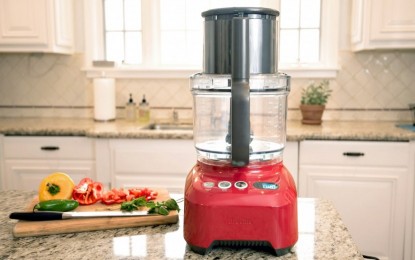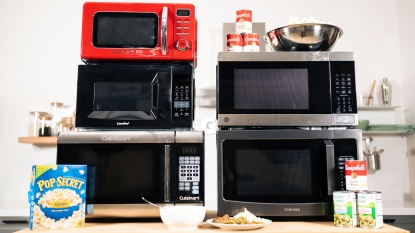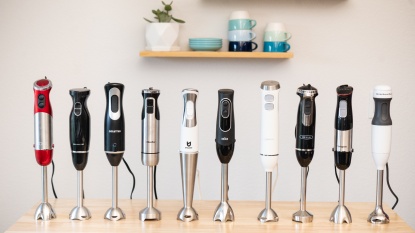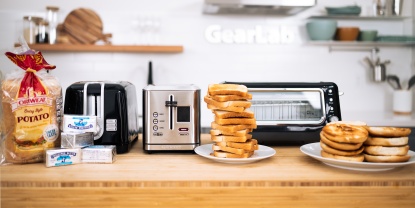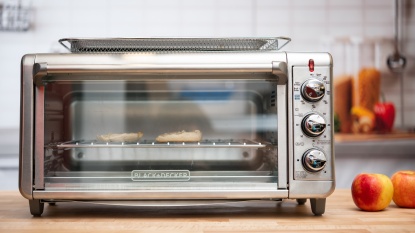Searching for the latest and greatest when it comes to kitchen appliances? Baffled by the barrage of new blenders on the market? We bought the best blenders on the market today and tested them head-to-head in our quest to find the best. In the process, we put together this guide to help you sort out the differences between a top-of-the-line $600 model or a much more economically priced $40 one, as well as explore the different types available, the features that you should care about (and the ones that you shouldn't), and the different pros and cons of each type. In addition, we also break down the differences between blending and juicing in case you are stuck in a conundrum between these two types of products. If you want to see how the different models that we tested fared in our side-by-side comparison tests, head on over to our full Blender review for a complete explanation of our testing process and procedures.
We remember when the first Ninja model came out about a decade ago, and they repeatedly turned jars of ice into snow in their infomercials like it was a miracle… and yet all of the models in this review can do just that without too much trouble! The latest buzz words are "nutrient extraction," which is supposedly better than blending, and yet happens in a "blender" with all the same parts, so it's no wonder people get confused. Manufacturers also like to hype the peak Horsepower ratings of their motors, which have little correlation to their actual running power, not to mention performance. Finally, with the price of some of these units exceeding $500, it can be hard to determine if you actually need to spend that much money to get a decent product or if something in the $100-$200 range can still get the job done well. This article will help you decide which model is right for you, no matter your budget or needs.
Types of Blenders
There are many different types of blenders available. We've tested the best hand-held immersion blenders (sometimes called stick blenders) and the best portable blenders that can only process a cup or two at a time, to conventional countertop models and advanced high-performance ones that used to only be found in commercial kitchens.
Countertop
Previously found mainly in commercial kitchens, high-performance models have been gaining popularity in home kitchens of late thanks to the rise in popularity of green smoothies, foodies, and some cool Costco demos. These models have powerful motors (at least 1400 Watts) and can complete a variety of tasks, from blending hard vegetables to grinding nuts and grains. They'll also typically have handy features, such as preset blending programs for common uses, like smoothies, and a digital timer. Expect to pay $400 and up for a good high-performance model.
These are the models that most of us are familiar with, and have probably owned at least one or two of. They don't have the powerful motors or fancy functions like a high-performance unit but are still strong enough to crush ice and blend fruits. These models typically cost around $100-200.
Personal or "bullet" models have been gaining in popularity in recent years, with infomercials touting their powers. These types process single servings in a to-go cup but typically have much less power than a high-performance or even conventional model. While we didn't specifically test any bullet models in this review, the Nutri Ninja DUO came with bullet cups, and we compared their performance when making smoothies to both the main Ninja jar and the rest of the models in this review.
Handheld
Immersion, or "stick," models are handheld units that are mostly used for pureeing soups in a pot, or light blending in a cup, like making salad dressings or other sauces. While high-speed commercial-grade immersion models are available and used frequently in professional kitchens, most home units are low wattage affairs. The benefit of an immersion model is that it can fit in a drawer and doesn't take up any countertop space, but it doesn't have the same capacities as a high-performance countertop unit, such as grinding nuts or making doughs.
We chose to focus on high-end and conventional countertop models for this review, for the sake of comparing apples to apples, and also because they are the most versatile options out there. While you might (like us) have cabinets full of different kitchen appliances — like a food processor, ice cream maker, immersion blender, juicer, and countertop blender — if all those various tasks can be accomplished by one machine, you'll save yourself a lot of money, not to mention storage space.
We chose to focus this review on conventional and high-performance models, as they are the most versatile, but the other options can serve you well for various uses.
Usage
A countertop model is one of those kitchen appliances that almost everyone owns but doesn't necessarily use. You might be enticed by an in-store demo or late-night infomercial to purchase one (it can turn grapes, carrots, and kale into a tasty drink? Sold!), but if you don't actually end up making funky smoothies or milling your own grains, then you probably don't need the ultra-expensive machine. On the other hand, you might not ever get into serious blending without a serious blender, a sort of "if you buy it, the smoothies will come" scenario. If you only plan on making simple smoothies and frozen drinks, then a conventional model with a less powerful motor will probably suffice, but if green smoothies and homemade nut butter are your cup of tea, then you'll want to invest in a more powerful option, which brings us to our next point.
Motor
There are a lot of specs that manufacturers like to tout when advertising their products, from Wattage to RPMs and Peak Horsepower. It's not only confusing to the consumer, but it also makes it difficult to compare models if they are discussing different specifications. Additionally, while we'd like to say that you need to buy a more powerful motor to get the best results, we experienced much better blending from the 720 Watt KitchenAid 5-Speed Diamond than the almost twice as "powerful" 1400 Watt Oster VERSA. All this to say that you should take the following information with a grain of salt, and know that there are a lot of factors that go into making a strong blender.
Peak Horsepower vs. Running powerManufacturers often tout the misleading "peak Horsepower" capabilities of their machines. This represents the maximum possible output when starting up the blender, and also what force is generated when the blades are stopped abruptly. No blender actually runs at peak Horsepower — it would cause the motor to fry out and/or trip a circuit breaker.
A better clue to the overall power and blending ability is the running power, which manufacturers like to tell you in Watts instead of Horsepower. Confused yet? They mean the same thing (Metric vs. Imperial systems), though Horsepower is used more commonly to relate mechanical power (say, for a motor) and Watts for everything else (like your microwave). The running power is a good indicator of the machine's strength but is not the sole determining factor when it comes to performance. This is where other factors, like blade and jar design, come into play.
Finally, if you read other specs like 28,000 RPMs or 300 MPH, you can probably ignore them, save for being a reminder never to stick your hand in one when it's running! There isn't a set standard by which to compare those figures, and the speed at which the blades spin will fluctuate depending on what settings you are using.
Pitchers
Most blenders come with plastic as opposed glass pitchers these days, though you can still find some less powerful models with glass containers. The high-performance models cannot use glass pitchers due to the risk of the container chipping with contents moving at such high speeds. No one wants glass shards in their smoothies. Plastic pitchers are lighter and less prone to breaking when dropped.
The shape of the pitcher is an important consideration depending on what you tend to blend the most. Pitchers will either have a square cut or more rounded edges. While both styles will make a decent smoothie, we had better results making nut butter and other spreads and purees in the round pitchers. In the square models, chunks would get pushed to the edges, and required more scraping and effort. The round and especially narrow containers had an easier time keeping the mixture consistent. The square and wider containers did better with frozen desserts and crushing ice, though, so they both have their benefits.
Blades
Another feature that manufacturers might use to help sell their product is how sharp, or dull, their blades are. We saw many different styles in this review, from serrated edges to flat and dull blades, to ones that could slice you if you weren't careful. In the end, what seemed more important was the vortex that the blades created rather than how sharp they were, as they move at such high speeds as to be able to break most things down even if they have no sharp edges. One thing to keep in mind with sharp blades is to be careful when cleaning around them.
Special care needs to be taken with the Ninja line, like the Nutri Ninja DUO that we reviewed. The patented vertical blade insert is removable, which can make cleaning easier, but also more dangerous when pouring. You have to remember to use the pour spout or remove the blade completely before pouring, as the blade mechanism can fall out and potentially slice you.
Presets
As blenders become "fancier," so do their controls and functions. Most of the high-performance models we tested come with preset functions that help take the guesswork out of blending. A smoothie cycle might start at a low speed to crush any ice and frozen fruit, then pulses a few times to make sure any wayward chunks get incorporated before blending at a high speed for the rest of the cycle. Using a preset might result in an over-blended drink when making something delicate like a frozen margarita, but if you are trying to heat a soup up and running your machine for six minutes, you'll be happy to leave the room knowing it'll turn itself off eventually. Some of the presets are somewhat unnecessary — you can run it for 20 seconds on medium to clean it instead of using a preset — but on the whole, we really appreciated them and how easy they make blending. We also liked having a digital timer, particularly when trying to follow a recipe or for certain blends.
Durability
When plunking down $500 plus for a machine, you'll want it to last more than a few months. The biggest thing to look for with an expensive high-end model is a good (and long) warranty that'll replace your machine if it breaks. Note that most warranties cover defects, not user error or normal wear and tear, so if you try your own "Will it blend?" tests and burn out your motor, that's your own fault. The high-performance models that we tested had warranties in the seven-eight year range, which seems pretty reasonable. Lower-end models typically only have a one-year warranty, but you're paying a fraction of the price.
Juicing vs. Blending
On a final note, you might be deciding between a juicer and a blender, and wondering which one is right for you. There's a lot of debate in the juicing and blending world, with juicers extolling the virtues of their high vitamin counts and blending devotees happier to have the added fiber. Juicers extract the liquid and soluble fiber from your fruits and vegetables, leaving the insoluble fiber (or pulp) behind. Blenders puree everything, keeping the pulp inside the drink. In an ideal world, you may own both, as some days a smoothie hits the spot and others a green juice is what you want, but if you're outfitting your first kitchen and deciding between the two, we'd recommend getting a blender first, as they have a wider range of uses beyond making drinks. If you never see yourself making soups and homemade hummus, and want drinks that pack the biggest nutritional punch, then go for a juicer. (You can juice a whole head of kale, four carrots, and a beet and have a tasty drink, but if you put all that in a blender it'll taste like "liquid compost," according to one of our testers.) There are also blender and juicer combos that allow you to do both — although like most multi-use appliances, these hybrids aren't 100% perfect at either job. But no matter what you choose, you'll be doing something good for your health.

